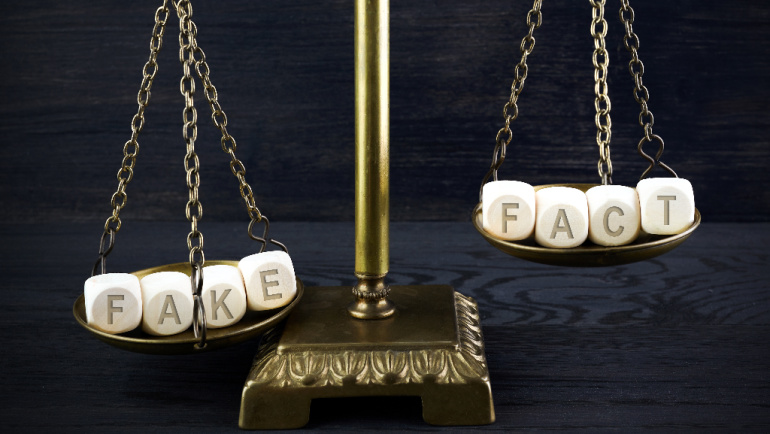
While the term “fake news” is relatively new to our national vocabulary, it has very real consequences. Recently, The New York Times has added a “daily distortions” section to its news site to combat falsehoods; similarly, social media giants Facebook and Twitter have started to flag content that is unverified or otherwise misleading.
Fake news entails the purposeful crafting of sensational — and often emotionally charged, misleading or entirely fabricated — information that is presented in a way that mimics mainstream news. Fake news is often discussed along with disinformation, in which deliberately misleading or biased information is spread with the intention of manipulation.
No matter the label, false or misleading information presented as news is a growing concern. Rosie Jahng, Ph.D. is an assistant professor in the department of communication within the College of Fine, Performing and Communication Arts, and her current research focuses on understanding what fake news is and how people make sense of both the contents and the accusations of “fake news,” as well as how to correct the impact of false information.

“We’ve reached the point where we have to go beyond basic fact checking and setting the record straight,” Jahng said. “Disinformation poses a real threat to the credibility and reputation of reliable news sources, and the idea of news in general.”
Jahng, along with co-authors Hyunmin Lee (Drexel University), Ph.D., and Annisa Rochadiat, a Ph.D graduate from the department of communication, recently published work in Public Relations Review that explores the key elements and information authentication tactics used by public relations practitioners in managing fake news. The study found fake news is usually related to a sociopolitical issue, and that social media has become the most common channel for the creation and distribution of fake news, in part because of its free and interactive platform.
In their study, Jahng and her co-authors surveyed 206 public relations practitioners to identify key elements of fake news, as well as strategies used by public relations practitioners to verify fake news, which may also be helpful for justifiably skeptical audiences when navigating social media:
Key elements of fake news
- Deceptive motives: Fake news seeks to manipulate public opinion or push a personal agenda, usually social, political or financial in nature, rather than inform in an unbiased manner. Fake news is often associated with extreme political opinions and positions.
- Misleading content intended to harm reputation: Fake news makes use of personal attacks and seeks to discredit or malign, often through use of unsubstantiated evidence, exaggerations, opinions or emotions, or controversy.
- Unsubstantiated evidence: Fake news does not have any supporting factors or evidence, and may be entirely fabricated.
- Exaggerations: Fake news is often sensationalized, with extreme headlines and over-the-top topics; facts are either exaggerated or minimized to accommodate a specific agenda.
- Opinions and emotions: Fake news is generated with a focus on creating a reaction and tends to include buzzwords and fear mongering designed to play on the emotions of a targeted audience. Fake news is frequently one-sided, and involves presenting speculation and opinions as facts.
- Controversy: Fake news is usually tied to a timely and controversial topic.
Strategies to verify fake news
- Traditional media/fact-checking: Public relations practitioners and audiences alike can cross-verify news content by searching for reliable sources, such as traditional media outlets NPR, CNN, AP, or Reuters. Audiences can also make use of local, national, and global sources to make sure all information is consistent, with no obvious differences in facts. When getting news on social media, audiences are encouraged to look at the profile from which content is shared to determine credibility.
- Crowdsourcing: In additional fact-checking, public relations practitioners rely on their own trusted professional networks to verify content. Audiences are encouraged to be careful when seeking news verification from friends or families, and to always double-check their sources.
- Check the source: Public relations practitioners are increasingly aware of fake news and are making conscious efforts to share content directly, rather than from outside sources. Audiences should consider where a news story is posted or shared; most reputable organizations will share directly to their own websites.
- Be skeptical of news that attributes controversial statements to officials or organizations: Similarly, news and media professionals reported actively avoiding promoting content that is ambiguous and might be misconstrued as controversial. Balanced and reliable news is most focused on facts — like time, date and other details — than political affiliations or taking a social stance.
The study also developed around the theme of a public relations practitioners’ professional ethics and standards, including objectivity, transparency, and a respect for citations and expertise.
“The lessons from these professionals are of value to the general public,” Jahng said. “No matter our profession, we should be able to agree that news should be built around objectivity and a steadfast commitment to the truth.”
Jahng is further developing her research on fake news, and is currently working on additional studies that focus on how journalists define and describe the phenomenon, how they differentiate their own news stories for audiences, and, more broadly, how they are intensifying their efforts to defend the legitimacy and significance of their profession for democracy. She also has a forthcoming publication that explores how an audience evaluates a brand that has been targeted in online disinformation, and how those organizations assess such a crisis and respond strategically. Additionally, Jahng has applied for a grant that will examine how factchecking sites can correct science-related fake news.
“Unfortunately, fake news has become a pervasive part of our media landscape, and an increasingly hot topic,” she said. “Public relations practitioners, journalists and audiences alike all play an important role in combatting fake news and defending the legitimacy of credible news, which is a cornerstone of democracy.”
